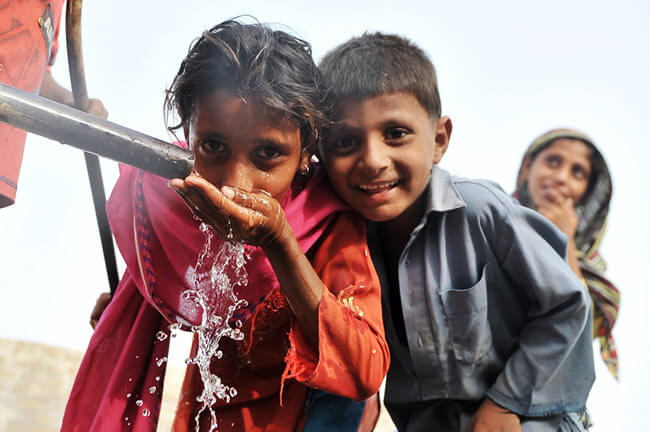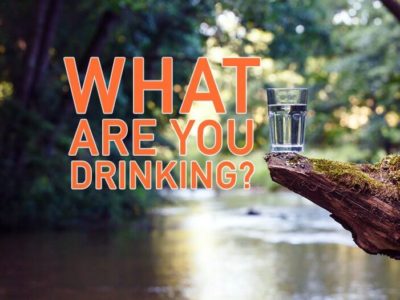Did you know that in parts of Alaska, North Dakota, Washington and Pennsylvania, tap water is carried in wooden pipes? These are hundred-year-old municipal plumbing systems, and there are many iron pipe systems of similar age, too. Miles and miles of underground piping is necessary to carry water from its source to a treatment facility, where it is cleansed of harmful bacteria and other toxins either by chlorination or ultraviolet light, and from there to all the homes and businesses where people expect to open a faucet and have safe, clean water flow out. Those pipes have a finite lifespan. Replacing underground pipes is not a small deal. We are currently right around pipe-replacement time for many municipal water systems, and it’s not yet clear how this is going to be managed.
When you’ve spent your entire life with water available to you simply by opening a faucet, it’s easy to take it for granted. So much so that even as a 4- or 5-year-old I remember disbelieving the part in The Tiger Who Came to Tea where the tiger “drank all the water in the tap.” Even at that age I had an understanding that “the tap” wasn’t merely a reservoir containing a finite amount of water, but opened up on water that just kept coming. On the other hand, in Israel in the summers we were only allowed a very small amount of water for baths or dishwashing, so I also learned that in hotter countries, where it rained less, the supply might be less than infinite.
Still, like most people I took tap water for granted. I drank filtered water from a pretty young age because of the chlorine, but I didn’t think twice about the water’s abundance, and I didn’t think twice about the fact that it was clean. Not until I lived for a few years in the jungle in Hawaii, where almost everyone was on some sort of rainwater catchment system, and then in Alaska, where many small homes have no indoor plumbing, and people haul water from a spring or from a municipal faucet, take showers at the laundromat, and use an outhouse as toilet. No indoor plumbing means no pipes to worry about freezing in winter, but a lot of extra hassle. And if you’re getting your water from a municipal faucet, you’re still dependent on the municipal supply, with its chlorine and whatever other issues from old pipes. Some of those faucets were outside, and they did sometimes freeze too… In Hawaii, jungle notwithstanding, there were times of drought, and people watched their tanks carefully. Many people had excellent DIY plumbing, but the water pressure still wasn’t the same as it would be in a regular home. And although it’s easy to assume rainwater’s the purest, cleanest water possible, there had been cases of leptospirosis in the community, which is a waterborne bacterial disease. Most people there used Berkey filters, which are low-tech, comprehensive, slow, gravity-based countertop filters that remove all harmful pathogens and chemicals and, because they aren’t hooked into the plumbing, can be used no matter where the water’s coming from.
I learned a lot from living in primitive conditions, but the lesson not to take water for granted was maybe the one that stuck most. Ever since, I’ve been curious about where my water’s coming from, where it’s going and what happens to it before and after I encounter it.

The United Nations recognized access to clean water as a basic human right in 2010. But 783 million people in the world do not have access to clean water.
And the truth is, even in the affluent West, especially with clean water production done on such a large scale and over such great distances, it’s really difficult to keep water clean. Researchers at the University of Sheffield in the United Kingdom recently showed that when one of those huge main pipes has a leak in it, as they inevitably will when they’re a hundred years old and more, it is actually possible for contaminated groundwater to leak into the pipe. It was previously thought that the sheer pressure of the water running through the pipe was enough to prevent anything else from coming in. But when there’s a sudden drop in pressure, as might happen when a large amount of water is being diverted for firefighting, the water on the outside of the pipe can end up on the inside.
Outside water is liable to harbor sewage, pathogens and other things you wouldn’t want in your glass of water. And, worse, in these low-pressure windows of opportunity, clumps of pathogens can glom on to the sides of the pipes and multiply. Not really what we were after when we treated the water.
So, what can we do?
- The first step is to be aware of where your water is coming from. The Environmental Protection Agency has a dedicated “Local Drinking Water Information” page, with information by state about the basic quality of water.
- Filter your water. This could be anything from a countertop filter to a kitchen sink filter to a whole-house system, and your personal circumstances will dictate which one makes sense for you. Whatever your circumstances, though, given this information, you probably recognize that you want something more comprehensive and protective than a Brita or Pur pitcher. Mike Adams of Natural News conducted lab research on an array of different filters and published results on WaterFilterLabs.com and NaturalNews.com.
- Fifteen percent of Americans obtain their water from their own well. This means by definition that they are consuming untreated groundwater directly. In some parts of the country, this can be wonderful fresh water. In others, toxicity syndromes related to minerals like arsenic, iron and lead become epidemic. In other words, if this is you, honor yourself as well as your water independence by getting the water tested.
- With some craft and ingenuity, an astonishing amount of rainwater can be harvested, diverted and utilized, even in the driest climates where otherwise it would just evaporate. Many communities have been able to meet all their water needs with rain catchment. This site is just one place to start researching that. In today’s climate, though, even rainwater may need treatment to be drinkable, given its exposure to airborne and atmospheric pollutants. And then there’s the tank and pipes to be kept clean too.
- Spring water! Whereas well water is deep-lying groundwater that’s fairly static and immobile, spring water bubbles out of the earth under its own momentum. If you take the water from the source of the spring, there’s no concerns about fecal coliforms from animals and hence Giardia, etc. It’s naturally cooled by moving through underground rocks. Many say it’s the best water you can possibly drink. Find out more, and put your own spring on the map at FindASpring.com. Note: While the fact that the water is moving seems to make it less likely that it might have high levels of one or another mineral like static groundwater does, there have been some reports of spring water having unfavorable mineral profiles. So testing the water even in this case would be prudent.
Takeaway: We take clean water for granted. We’re told that we’re entitled to take clean water for granted. But we shouldn’t take it for granted. And there’s already a lot of knowledge and information out there about how to take responsibility for our own water. At the very minimum, be aware of where your water is coming from, what might be in it and what you can do to improve its quality. After all, you are 75 percent water.


